|
The Giant Panda
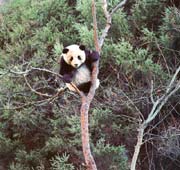 Distributed in the bamboo below the coniferous forest and theropencedrymion with an altitude between 1300-3200 meters, the giant panda likes living alone and roaming to pick up bamboo stems, shoots or leaves for food either during the day or at night. It has a home range of 5-7 square meters. The giant panda can climb trees, swim through the water, but does not hibernate in winter. Mating usually in Distributed in the bamboo below the coniferous forest and theropencedrymion with an altitude between 1300-3200 meters, the giant panda likes living alone and roaming to pick up bamboo stems, shoots or leaves for food either during the day or at night. It has a home range of 5-7 square meters. The giant panda can climb trees, swim through the water, but does not hibernate in winter. Mating usually in 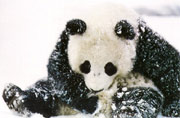 March or April, it gives birth to panda cubs in September or October, often one cub- sometimes two cubs, and rarely three- in each pregnancy. A peculiar rare animal to China, it is listed in Appendices I of CHINA'S NATIONAL LIST FOR SPECIALLY PROTECTED WILD ANIMALS. It's a species threatened to be extinct. March or April, it gives birth to panda cubs in September or October, often one cub- sometimes two cubs, and rarely three- in each pregnancy. A peculiar rare animal to China, it is listed in Appendices I of CHINA'S NATIONAL LIST FOR SPECIALLY PROTECTED WILD ANIMALS. It's a species threatened to be extinct.
The Red Panda
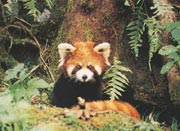 The red panda is mainly distributed in the northwest edge and west edge of the Sichuan Basin and the southwest mountains of Sichuan province. Living in the broadleaved forest, theropencedrymion and coniferous forest, the red panda often moves around in the bamboo below the woods. In summer, it prefers to live in the shady slope of a river valley while in winter it often moves to the sunny slope or a flat-topped ridge to have a sunbathing. Although preferring warm environment, the red panda has good resistance to coldness. Red pandas often live in a small group of three to five and move about in a relatively certain area in the morning and evening. The diet of the red panda mainly consists of bamboo leaves and roots. It usually ruts and mates in spring. After four months¡¯ pregnancy, it often gives birth to two or three cubs, and one or five in rare cases. An animal only found in the Himalayan intersectional mountain range. In CHINA'S NATIONAL LIST FOR SPECIALLY PROTECTED WILD ANIMALS, it is listed in Appendices II. It's a species threatened to be extinct. The red panda is mainly distributed in the northwest edge and west edge of the Sichuan Basin and the southwest mountains of Sichuan province. Living in the broadleaved forest, theropencedrymion and coniferous forest, the red panda often moves around in the bamboo below the woods. In summer, it prefers to live in the shady slope of a river valley while in winter it often moves to the sunny slope or a flat-topped ridge to have a sunbathing. Although preferring warm environment, the red panda has good resistance to coldness. Red pandas often live in a small group of three to five and move about in a relatively certain area in the morning and evening. The diet of the red panda mainly consists of bamboo leaves and roots. It usually ruts and mates in spring. After four months¡¯ pregnancy, it often gives birth to two or three cubs, and one or five in rare cases. An animal only found in the Himalayan intersectional mountain range. In CHINA'S NATIONAL LIST FOR SPECIALLY PROTECTED WILD ANIMALS, it is listed in Appendices II. It's a species threatened to be extinct.
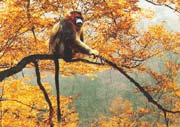 The Golden Money The Golden Money
The Golden Monkey lives both in the trees and the ground of the theropencedrymion or coniferous forest with an altitude of 1400m to 3200m. Moving about in groups during the day, the golden monkeys sleep in big trees in groups of three to five. They move vertically in accordance with the season. In summer, they live in the forest with at an altitude of about 3000 meters while getting down to the woods below 1500 meters in winter. They search for food and play in the trees or on the ground, but only rest in the trees. The diet of a golden monkey consists of plant sprouts, tender blossoms, barks, wild fruits and seeds, and bamboo shoots. Although showing no preference for seasons in breeding, the peak time of mating is between October and August. After 193-203 days' pregnancy, a golden monkey often gives birth to a cub at a time between March to May. In CHINA¡¯S NATIONAL LIST FOR SPECIALLY PROTECTED WILD ANIMALS, it is listed in Appendices I. It's a species threatened to be extince.
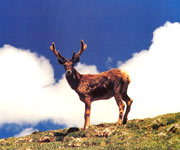 the White-Lipped Deer (Cervus albirostris) the White-Lipped Deer (Cervus albirostris)
The white-lipped deer lives in the shrubberies, meadows of the forest in the high mountains with an altitude above 3500 meters. Good at climbing over the quickstones, crags and cliffs, it often hides itself in the shrubbery on the edge of a forest. White-lipped deer live in society and move vertically in accordance with the season. They search for food in the morning and evening, feeding mainly on grasses. Its diet also includes tender sprouts. They often rut and mate in September or August. After eight or nine months' pregnancy, a white-lipped deer often gives birth to a baby deer at a time between May to July. A species peculiar to China, it is listed in Appendices II of CHINA'S NATIONAL LIST FOR SPECIALLY PROTECTED WILD ANIMALS. It's a species threatened to be extince.
White-rumped deer (Ce macneilli)
The white- rumped deer lives in the high mountains with an altitude above 3500 meters. In summer, it goes to the shrubberies of drifting sand while in winter moves down to take shelter from wind in the sunny meadows or a valley. White-rumped deer live in society. Their diet mainly includes sprouts and tender leaves. They also feed on dry grass and barks in winter. They often rut and mate in September or August. After 230 to 240 days' pregnancy, a white-bumped deer often gives birth to a baby deer at a time between May to July. In CHINA'S NATIONAL LIST FOR SPECIALLY PROTECTED WILD ANIMALS, it is listed in Appendices II as a species threatened to be extinct.
Natural Resources in the Wolong Natural Reserve
Takin.snow leopard.Neofelis nebulosa.Leopard.The Tibetan macaque
|



